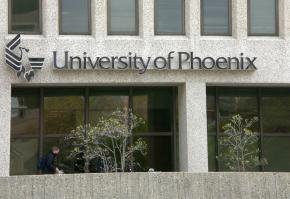The for-profit university scam
, a community college instructor and member of American Federation of Teachers Local 1493, explains how for-profit colleges make out like bandits.
ACROSS THE nation, record numbers of people are returning to post-secondary schools.
The students are a more diverse population than ever. In community colleges, you'll find younger students who can't get into four-year universities because of budget cuts, alongside laid-off or underemployed workers seeking new skills. But community colleges are struggling to handle the increased demand for classes at a time when they are facing the consequences of state budget deficits that have forced cutbacks.
One sector of the college education system is doing quite well for itself, however--the for-profit university, whose enrollment has increased from 365,000 to 1.8 million in just the last several years, according to government statistics.
The for-profit higher education industry, which includes schools like the heavily advertised University of Phoenix, has finally started to receive attention and criticism. In August, the Government Accountability Office (GAO) released the results of a study of 15 for-profit universities.

According to the GAO, undercover investigators posing as new applicants were encouraged to submit false information on their financial aid applications at four schools. And all 15 universities provided deceptive information about the cost of their program, students' job prospects afterwards and the length of time that it would take to finish their program.
The schools have also been criticized for their low graduation rates. A Bloomberg BusinessWeek article cited federal statistics showing that about 38 percent of students at for-profit four-year colleges graduate within six years, compared with 53 percent at public institutions and 64 percent at nonprofits.
Critics have also zeroed in on the little-talked-about scandal of the for-profit colleges--the way they thrive on loading students up with loan debt.
The for-profits take an assembly-line approach to getting students to apply for financial aid. According to the GAO, for example, "In 2009, students at for-profit colleges received more than $4 billion in Pell Grants and more than $20 billion in federal loans provided by the Department of Education."
That's money in the bank for a school like the University of Phoenix--at the 15 colleges that the GAO studied, federal student aid money accounted for 89 percent or more of total revenue.
But the burden of loan debt will haunt students for years to come.
About 12 percent of U.S. college students attend for-profit institutions--but these students account for about a quarter of student loan dollars, according to a study by the Institute for College Access and Success (ICAS) cited by BusinessWeek.
What's more, ICAS President Lauren Asher pointed out to BusinessWeek, "about 43 percent of all former students who defaulted by 2010 on loans they began paying off in 2008 were from for-profit colleges."
And who are the students attending these money-making ventures? Almost half of students at for-profit universities are minorities and some two-thirds have incomes that fall below the median for undergraduates. "The data clearly show that across levels of income and categories of race/ethnicity, for-profit college students borrow more than those who attend elsewhere," Asher said.
So far, the only response of the Obama administration has to support regulations on the for-profit industry put together by the Government Accountability Office. The proposals barely scratch the surface of the problem--but even so, it will be an uphill battle to get them passed.
According to an article at the Inside Higher Ed Web site, the proposed regulations would remove so-called "safe harbors," which allow recruiters to receive limited compensation for recruitment, among other benefits.
One of the most highly contested regulations, which would cut off federal student aid funding to programs whose graduates have high student loan debt relative to their incomes, has been postponed until next spring. This rule, according to Inside Higher Ed, would "call on institutions to provide data on students' debt levels and job placement and graduation rates, both to the department and for public disclosure on their own Web sites." The aim would be to measure "the relationship between the debt students incur and their incomes after program completion; and measuring the rate at which all enrollees, regardless of completion, repay their loans on time."
The idea is that if a large percentage of students have high debt-to-earnings ratios, the program would be required to disclose this to students, and would potentially lose its eligibility to receive federal student aid. The hope is that since these schools rely on such a high percentage of federal money, they would be forced to change or fail.
Whether any of the regulations will pass is an open question since the for-profit schools are lobbying furiously to block the new rules. But even if they do pass, while a step in the right direction, they wouldn't put an end to the inequality, ineffectiveness and devaluation of educators that come from privatizing education.
At a time when public colleges across the nation are struggling to keep core classes and laying off instructors and staff, the for-profit universities are thriving, thanks to federal taxpayer dollars. That's an indictment of the backward priorities of Washington and the Obama administration.


